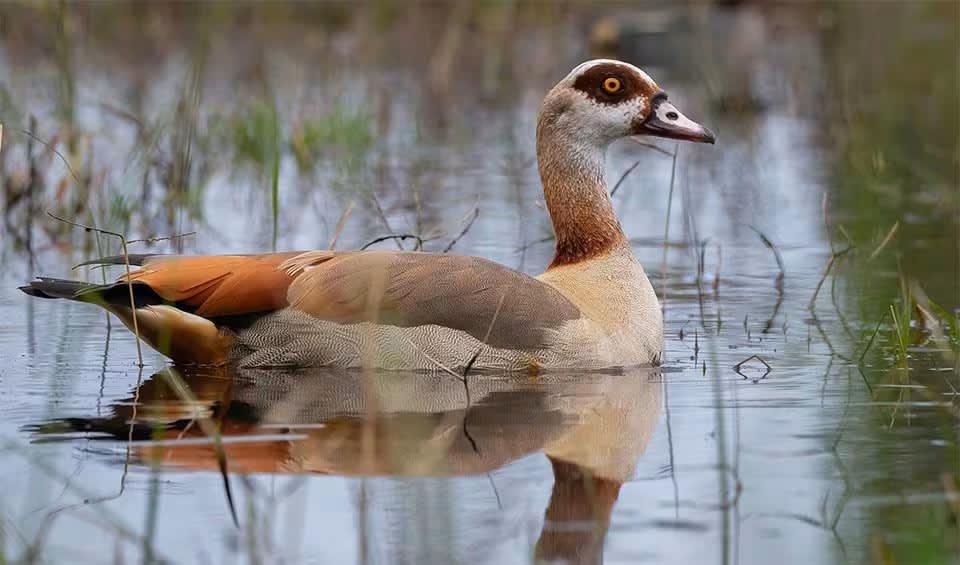It is native to Africa, where it is widespread south of the Sahara and in the Nile Valley. Egyptian geese have also been introduced to other parts of the world, such as Western Europe, and have established feral populations, particularly in the United Kingdom and the Netherlands.
As a medium-sized bird, the Egyptian goose typically measures 63 to 73 centimeters in length and has a wingspan of 110 to 135 centimeters. Both sexes display similar plumage, with greyish-brown back feathers and a lighter chest. The most striking features are the dark brown eye patch and the chestnut ring around their eyes, which give them a distinctive and somewhat stern appearance. Additionally, they have conspicuous white wing patches that become visible in flight.
These geese are known for their loud, harsh calls, which can often be heard at great distances, especially during their breeding season. They are also known for their aggressive behavior, particularly in defending their territory and young.
In terms of habitat, Egyptian geese are quite adaptable and can be found in a variety of wetland habitats, including lakes, rivers, marshes, and agricultural lands. They have adapted well to urban environments and can commonly be seen in city parks and on golf courses where there are bodies of water.
Monogamy is a significant aspect of the social behavior of the Egyptian goose. Pairs form strong, enduring bonds and are often seen together throughout the year. During the breeding season, both male and female collaborate in building a nest, which is typically located near water on the ground among tall vegetation or occasionally in a tree or on a building. They show a high degree of parental care, with both parents involved in incubating the eggs and raising the young.
Distribution
 Algeria
Algeria Angola
Angola Austria
Austria Belgium
Belgium Benin
Benin Botswana
Botswana Burkina Faso
Burkina Faso Burundi
Burundi Cameroon
Cameroon Central Af. Rep.
Central Af. Rep. Chad
Chad China
China Congo-Brazzaville
Congo-Brazzaville Cyprus
Cyprus Côte D’ivoire
Côte D’ivoire DR Congo (Kinshasa)
DR Congo (Kinshasa) Denmark
Denmark Djibouti
Djibouti Egypt
Egypt Equatorial Guinea
Equatorial Guinea Eritrea
Eritrea Eswatini
Eswatini Ethiopia
Ethiopia France
France Gabon
Gabon Gambia
Gambia Ghana
Ghana Guinea-Bissau
Guinea-Bissau Guinea
Guinea Hungary
Hungary Israel
Israel Official estimate
Official estimate
 Kenya
Kenya Lesotho
Lesotho Malawi
Malawi Mali
Mali Malta
Malta Mauritania
Mauritania Mozambique
Mozambique Namibia
Namibia Netherlands
Netherlands Niger
Niger Nigeria
Nigeria Oman
Oman Qatar
Qatar Rwanda
Rwanda Senegal
Senegal Somalia
Somalia South Africa
South Africa South Sudan
South Sudan Spain
Spain Sudan
Sudan Tanzania
Tanzania Togo
Togo Tunisia
Tunisia UAE
UAE Uganda
Uganda United Kingdom
United Kingdom Zambia
Zambia Zimbabwe
ZimbabweAnything we've missed?
Help us improve this page by suggesting edits. Glory never dies!
Suggest an editGet to know me
Terrestrial / Aquatic
Altricial / Precocial
Polygamous / Monogamous
Dimorphic (size) / Monomorphic
Active: Diurnal / Nocturnal
Social behavior: Solitary / Pack / Herd / Flock
Diet: Carnivore / Herbivore / Omnivore / Piscivorous / Insectivore
Migratory: Yes / No
Domesticated: Yes / No
Dangerous: Yes / No




